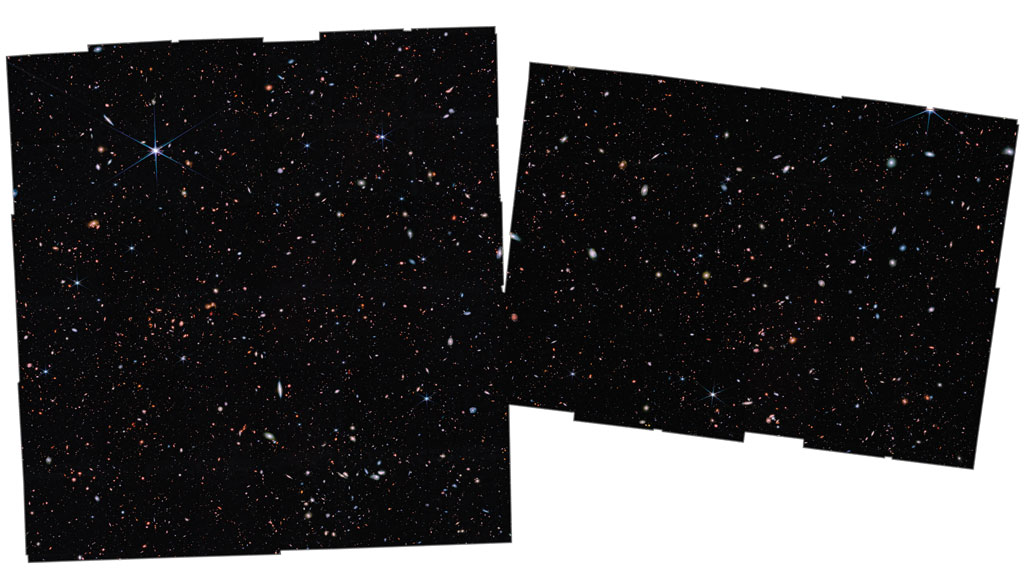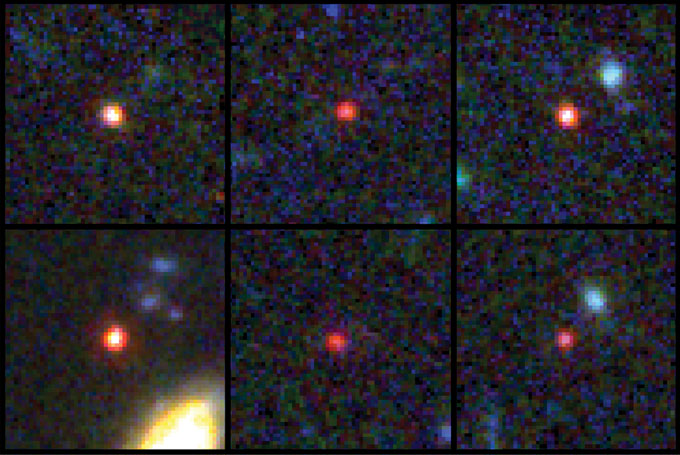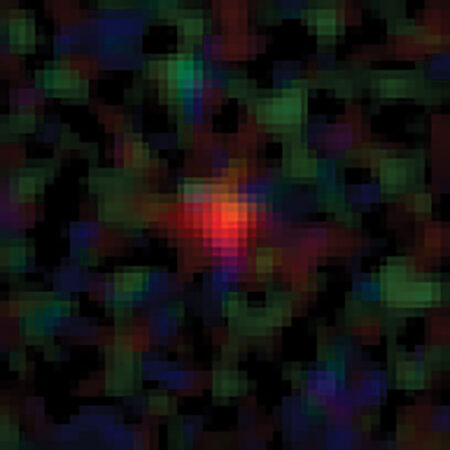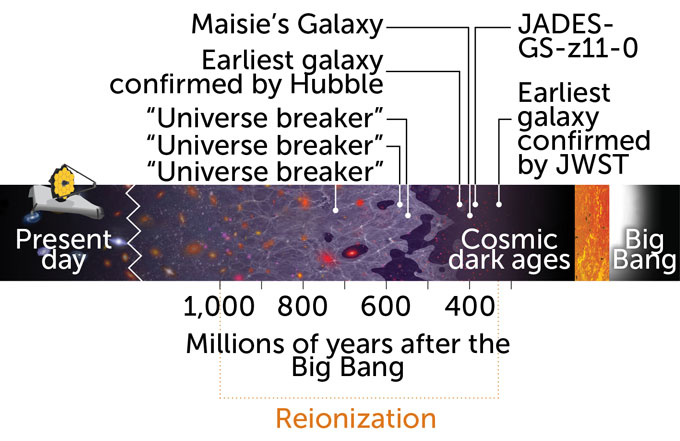This post was originally published on this site
When Brant Robertson saw a new measurement of the distance to a familiar galaxy, he laughed out loud.
For more than a decade, the galaxy had been a contender for the most distant ever observed. In 2012, Robertson and colleagues used data from the Hubble Space Telescope to show that the galaxy’s light had shone across the universe from about 13.3 billion years ago — less than 400 million years into the universe’s existence.
Not everyone believed it. “We got a lot of flak,” recalls Robertson, an astrophysicist at the University of California, Santa Cruz. “It seemed too implausible that it was at such a great distance.” It felt like he was going around claiming to have seen the Loch Ness monster.
But in September, the James Webb Space Telescope, JWST for short, aimed its massive mirror and sensitive spectrograph at the same galaxy and showed that Robertson and his colleagues were right. The galaxy’s light is indeed incredibly old, dating to just 390 million years after the Big Bang. It was like someone had drained the lake, and the monster was sitting there at the bottom.
And this galactic Nessie is not alone. So far, in its first year of observations, JWST has turned up thousands of distant galaxies dating to the early universe, many more than astronomers had expected. Some of those galaxies are brighter, more massive or more mature than astronomers would have thought. They are now scratching their heads trying to explain how the galaxies could have grown up so fast.

A lot of the extreme distances still need to be confirmed, but initial evidence suggests there’s reason to believe that many, if not most, of the galaxies really are that far away.
“I was expecting to find some galaxies at this [distance]. Some people were pessimistic; I wasn’t,” says Steven Finkelstein, an astrophysicist at the University of Texas at Austin. “But I was not this optimistic. I thought, ‘Yeah, yeah, we know what we’re going to see.’ And I was wrong.”
The Hubble Space Telescope’s distant galaxies
For longtime galaxy hunters, JWST’s bounty may feel like déjà vu. In the 1990s, Hubble took a long, deep look at an apparently blank patch of sky, just to see what was there. The result was thousands of galaxies, some captured as they looked when the universe was only a billion years old.
Those galaxies looked mature, like they had already been through multiple rounds of supernova explosions and star formation. Thus, they were not the first to form in the universe, astronomers realized. The first galaxies must date even further back.
The hunt for those original galaxies was part of the motivation for building JWST, says astrophysicist Erica Nelson of the University of Colorado Boulder. “The reason we have JWST is, they launched Hubble and saw that the things in the early universe were very evolved,” she says. “They were like, ‘Wow! There are galaxies way earlier than we thought’ ” — even further back in time than Hubble can see.
Hubble wasn’t designed to see all the way back to the universe’s beginning. The telescope is sensitive to ultraviolet, visible and near-infrared wavelengths of light. But by the time light from the universe’s early days reaches us, it has stretched all the way into infrared wavelengths that are longer than Hubble’s (or human) eyes can see. That’s because the universe is expanding; everything in it is moving away from everything else. And as light sources move away from us, their light stretches — the wavelengths of light grow longer, or redder.
The amount of stretching of that light, known as the redshift, is astronomers’ proxy for cosmic distance and age. The present-day universe is at redshift zero. A redshift of 1 corresponds to about 6 billion years after the Big Bang. A redshift of 4 is about 1.5 billion years after the Big Bang, and so on.
In 1995, redshift 4 was the furthest back that Hubble could detect. Over the next 20 years, upgrades to the telescope and new observing techniques pushed the frontier back to redshift 7, which corresponds to 800 million years after the Big Bang. In 2012, the galaxy that Robertson studied appeared at a possible, though at the time unconfirmed, redshift of 11.9. Later, a galaxy called GN-z11 clocked in at a redshift of 11.1, or 400 million years after the Big Bang.
These tantalizing discoveries set off a search for even more distant galaxies. “This has kind of become a game in extragalactic astronomy, where everyone wants to find the highest redshift, most distant galaxy,” astrophysicist Jeyhan Kartaltepe of the Rochester Institute of Technology in New York said in April in Minneapolis at an American Physical Society meeting. “Become the new record holder, right? It’s fun.”
By 2016, when GN-z11 was discovered, the hunt had stalled. Astronomers had wrung everything they could out of existing technology.
“It really requires JWST to push to even earlier times,” Kartaltepe said, “which we need to understand the very beginnings of galaxy formation.”

Why astronomers want to find early galaxies
The quest to find the earliest galaxies is about more than just bragging rights. These galaxies could shed light on a key event in the universe’s infancy called reionization.
In the beginning, there was the Big Bang. After that initial cataclysm, the universe continued to expand and cool. After about 372,000 years, it had cooled enough for electrons, protons and neutrons to combine into hydrogen atoms. That hydrogen gas was diffuse and opaque, plunging the universe into what astronomers call the cosmic dark ages.
Sometime during these dark ages, the first stars formed and began to clump together into galaxies with the help of an invisible and still mysterious material known as dark matter. But because of the opacity of that neutral hydrogen, all astronomers can really observe is that the universe became transparent again at about 200 million years after the Big Bang, as hydrogen atoms lost their electrons.
“We know there was a transition where the hydrogen was reionized somehow,” Robertson says. Thanks to observations with Hubble and other telescopes, “we think galaxies are very likely the agents of that process,” he says. Light from the youngest, most massive stars in those early galaxies might have knocked electrons off atoms in the hydrogen gas between galaxies. “But how that process unfolds, we have relatively little information on,” Robertson says.
JWST can help fill in those details. Taking a census of the galaxies that were around during the era of reionization could help illuminate how it got started.
And so, astronomers were giddy with excitement when JWST launched on Christmas Day in 2021 and started collecting data about six months later. The first images were unveiled with great fanfare on July 12, 2022 (SN: 8/13/22, p. 30). But astronomers had to wait until the next day to download the rest of the data the telescope had acquired while getting up and running.
“We knew, somewhere, on some computer, our photons were sitting there, waiting for us to see them,” Kartaltepe said. “As soon as the data were released in July, we jumped on it and started analyzing.”
Astronomers sifted through the images like a cosmic Where’s Waldo, picking the reddest-looking candidate galaxies out of the pack.
Extremely distant candidates popped out quickly. In several different regions of the sky, JWST found little red dots corresponding to galaxies that appeared to be at astonishing redshifts: 10, 13, even 17. Some of the galaxies seemed small and dim, as expected. But others looked big and bright, suggesting they were heftier than astronomers would expect for such early galaxies.
“These galaxies, they’re just at phenomenal distances. It’s a little hard to swallow,” Robertson said in June in Cambridge, Mass., at the JWST First Light Conference. “But it’s really important to actually confirm the distances to these very, very distant galaxies, and then learn about their properties.”
The most distant galaxy ever confirmed
Most of the cosmic distances reported for JWST galaxies so far have been preliminary estimates based on data from the telescope’s cameras. The cameras scan broad areas of sky and use filters to let in certain wavelengths of light. These filters allow astronomers to estimate “photometric” redshifts.
But to know for sure how far away a galaxy really is, astronomers need to use JWST’s spectrograph. A redshift calculated from a galaxy’s full spectrum of light uses 1,000 data points compared with a photometric redshift’s seven data points.
“Until we have spectra, nothing is ironclad,” Nelson says.
As part of a project called the JWST Advanced Deep Extragalactic Survey, or JADES, Robertson and colleagues collected spectra for four galaxies with photometric redshifts higher than 10 — likely close to the beginning of the era of reionization. One of the galaxies was the one Robertson studied in 2012. The distance of that galaxy, now known as JADES-GS-z11-0, was downgraded a bit, from a redshift of 11.9 to 11.58. But with one of the other galaxies, the team claimed a new record for most distant galaxy ever confirmed, with a redshift of 13.2, just 325 million years after the Big Bang.
The spectra the team analyzed were detailed enough to reveal some properties of the galaxies, Robertson and colleagues reported in April in Nature Astronomy. They’re all about a hundredth the size and mass of the Milky Way, but they are forming stars at a comparable rate — a lot of stars for galaxies this small. All those newborn stars produce a lot of ionizing radiation, meaning it’s possible these galaxies could be some of the earliest agents of reionization, Robertson says.
JADES has since reported about 700 more galaxies whose photometric redshifts place them at redshift 8 or greater, or less than 650 million years after the Big Bang, Robertson said at the June First Light meeting. Those galaxies’ distances still need to be confirmed, but the sheer numbers are amazing. “We’re really in a remarkable age,” Robertson said.
Trusting JWST’s measurements
The huge galaxy haul raises another question: How many of them are likely to be at such great distances?
A potential record-breaking galaxy called CEERS-93316 is a cautionary tale. The galaxy was identified in JWST images taken for the Cosmic Evolution Early Release Science, or CEERS, survey. Those images put the galaxy at a photometric redshift of 16.4, or just 240 million years after the Big Bang.
“That was higher redshift than we expected to see with CEERS,” says Finkelstein, the survey’s lead researcher. CEERS was designed to practice using JWST in its different observing modes and give astronomers some data to play with, not necessarily to set new records.
In its first chunk of data, CEERS contained a surprising number of apparently high-redshift galaxies. So Finkelstein and colleagues asked the director of the Space Telescope Science Institute in Baltimore, which operates JWST, for some extra telescope time to chase down the spectra of CEERS-93316, as well as a galaxy that Finkelstein had found with a photometric redshift of about 12. He named that galaxy Maisie’s Galaxy in honor of his daughter, because he found it on her ninth birthday. (Maisie didn’t mind that her dad had to work that day — “I got other birthday presents,” she says, though she did wish her galaxy was the potential record holder.)
When the spectral data came through, Finkelstein’s colleague Pablo Arrabal Haro, an astrophysicist at the National Science Foundation’s NOIRLab, based in Tucson, worked through the weekend to write up results before anyone else.
CEERS-93316’s 16.4 redshift turned out to be wrong. The galaxy was actually at a redshift of 4.9, putting it 1.2 billion years after the Big Bang — practically modern compared with some of JWST’s other finds.
The galaxy’s photometric redshift was so high because of a weird coincidence. Light streaming from hydrogen in the galaxy was redshifted such that it looked like it jumped in brightness at a wavelength suggestive of the huge distance. But when the full spectrum came in, that single jump was revealed to be several separate peaks, suggesting a smaller redshift.
Maisie’s Galaxy, however, is almost as distant as the photometric redshift implied, Arrabal Haro and colleagues reported in a paper posted in March to arXiv.org. And in an April paper posted to arXiv.org, the team reported spectra for more than 30 other galaxies with redshifts of roughly between 8 and 10. So photometric redshift estimates are generally reliable, Finkelstein says.
“Although we have this notable failure case, that’s a pathological case,” he says. It’s “not devastating.”
That’s good news for JWST’s observing schedule: Astronomers won’t have to follow up with the full spectrum for every distant galaxy. They can believe that most of the redshifts are legit and save the extra effort of taking the full spectrum for the really interesting ones. “It is exciting that the photometric redshifts tend to hold up,” Robertson says. “It gives us some hope that some of these really distant things could be real.”
Distant galaxies too bright to explain
Another outcome of JWST analyses so far is that there are more bright galaxies around redshift 10 than expected. Galaxy brightness is an indicator of galaxy mass, and thus star abundance. The brighter the galaxy, the more stars it must have to produce all that light.
Galaxies are born in halos of dark matter, whose gravity pulls in and concentrates ordinary matter. Cosmologists know from simulations and theory how many dark matter halos the universe would have had when the first galaxies formed. They also have a decent idea of how massive those halos were in the universe’s first 500 million years and how much of that mass ended up in the form of hydrogen and helium, the raw material for making stars. Theoretically, if all that gas turned into stars, the largest a galaxy could get would be about 10 billion times the mass of the sun.
In reality, researchers expect early galaxies to be much less massive, because modern galaxies never convert all their gas into stars.
JWST has not turned up any galaxy near the theoretical upper limit. But it has found many more hefty early galaxies than predicted. The confirmed JADES galaxies weigh in at about 100 million solar masses, just 330 million years after the Big Bang. Some of the CEERS galaxies seem to have over a billion suns’ worth of stars as early as 450 million years after the Big Bang. Two galaxies discovered in another JWST survey, called COSMOS-Web, appear to be about 5 billion solar masses as early as 350 million years after the Big Bang, astronomer Caitlin Casey of the University of Texas at Austin said at the June First Light meeting.
“With these massive beacons, you can test the limits of how fast you can assemble that much matter in the short time between the Big Bang and the time that we’re observing them in,” she says.
What astronomers find from these galaxies could point to where our existing understanding of galaxy formation is wrong. Or researchers might discover that some of the galaxies’ light doesn’t come directly from stars but instead from the ionized gas in between stars that are actively forming, Casey says. That would mean the galaxies aren’t actually as massive as they look.
Finding out how early galaxies were put together is the first step to understanding our own galaxy, Robertson says. “That’s ultimately what drives a lot of galaxy formation research, is trying to understand how our home, the thing that’s important to us, the place that we live, came to be,” he says. “We’re never going to complete that full story without looking at how galaxies at redshift 10 were put together…. That’s the starting place for how we got here.”
Breaking the universe … or not
One set of galaxies has sparked debate over not just galaxy formation, but the theoretical foundations of the universe itself.
In February, Nelson and colleagues reported six galaxies spotted with CEERS that seem to have grown so big, so fast that they directly challenge the standard theory of how structure forms in the universe (SN: 3/25/23, p. 14). These galaxies have photometric redshifts between about 7 and 9, meaning they grew up in the first 800 million years of the universe. But their stellar masses appear to rival or exceed that of the Milky Way, about 60 billion solar masses.
Nelson affectionately calls them the “universe breakers.” Nothing that massive should have been able to form that fast, she says. “As soon as we saw it, we were like, this is bananas.”
Barely enough ordinary matter is even believed to have existed back then to create the universe breakers, says astrophysicist Mike Boylan-Kolchin of the University of Texas at Austin. Regions where budding galaxies formed would have had to turn all their atoms into stars.

“We have this reservoir of atoms,” he says. “Almost every single one of them has to be in stars or in galaxies” if the universe breakers are for real. “If these observations and their interpretation is correct … it’s very hard to accommodate them in our current models,” he says.
Over the last few months, theorists have come up with several ways to explain the universe breakers. One of the most dramatic options would be to add some extra dark energy, the mysterious substance that drives the universe to expand faster and faster, to the early universe, which would speed up all sorts of cosmic processes.
“That would go in the right direction here, in the sense that there’d be bigger reservoirs [of atoms] and maybe more of them at earlier times,” Boylan-Kolchin says. “These early dark energy models do predict faster evolution of structure at early times.”
More mundane options include super-compact early galaxies that could have converted all their gas into stars before the oldest stars had a chance to go supernova and blow it away. Such efficient star formation could explain the universe breakers without breaking the universe, physicist Avishai Dekel of the Hebrew University in Jerusalem and colleagues suggested in a paper published May 25 in the Monthly Notices of the Royal Astronomical Society.
And there’s still the question of whether the universe breakers’ masses and distances will hold up. A spectrum of one of them has already revealed it to be a galaxy at redshift 5.6 with an actively feeding black hole creating extra light — so not a universe breaker after all.
JWST’s second observing cycle began in July, and Nelson will take spectra of the rest of the universe breakers to find out if they are truly abounding with stars, filled with black holes or something else.
Meanwhile, another group of astronomers will test JWST’s limits, hunting for galaxies at redshift 15 or greater. So by the telescope’s second birthday next summer, there may be new distance records.

